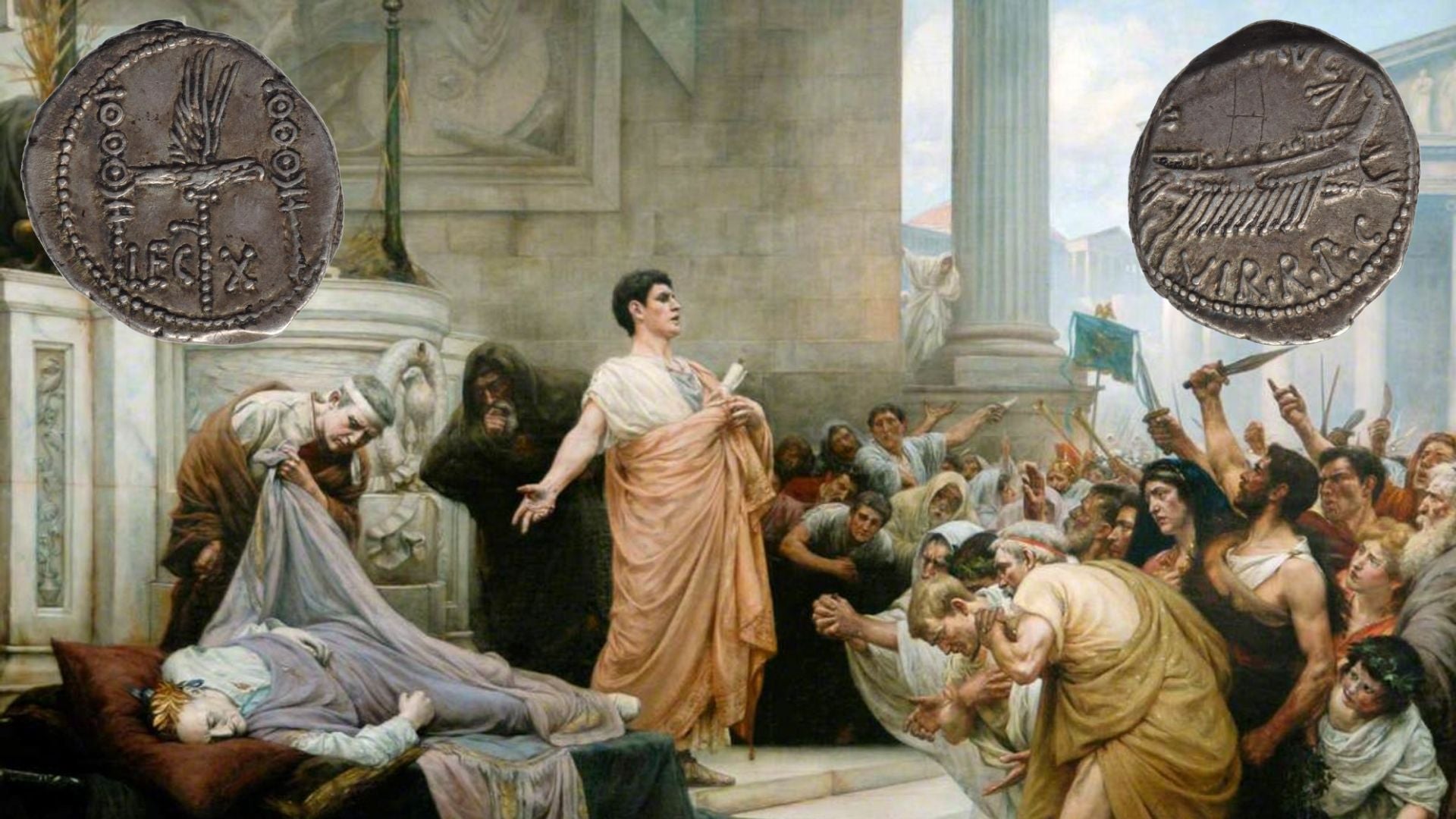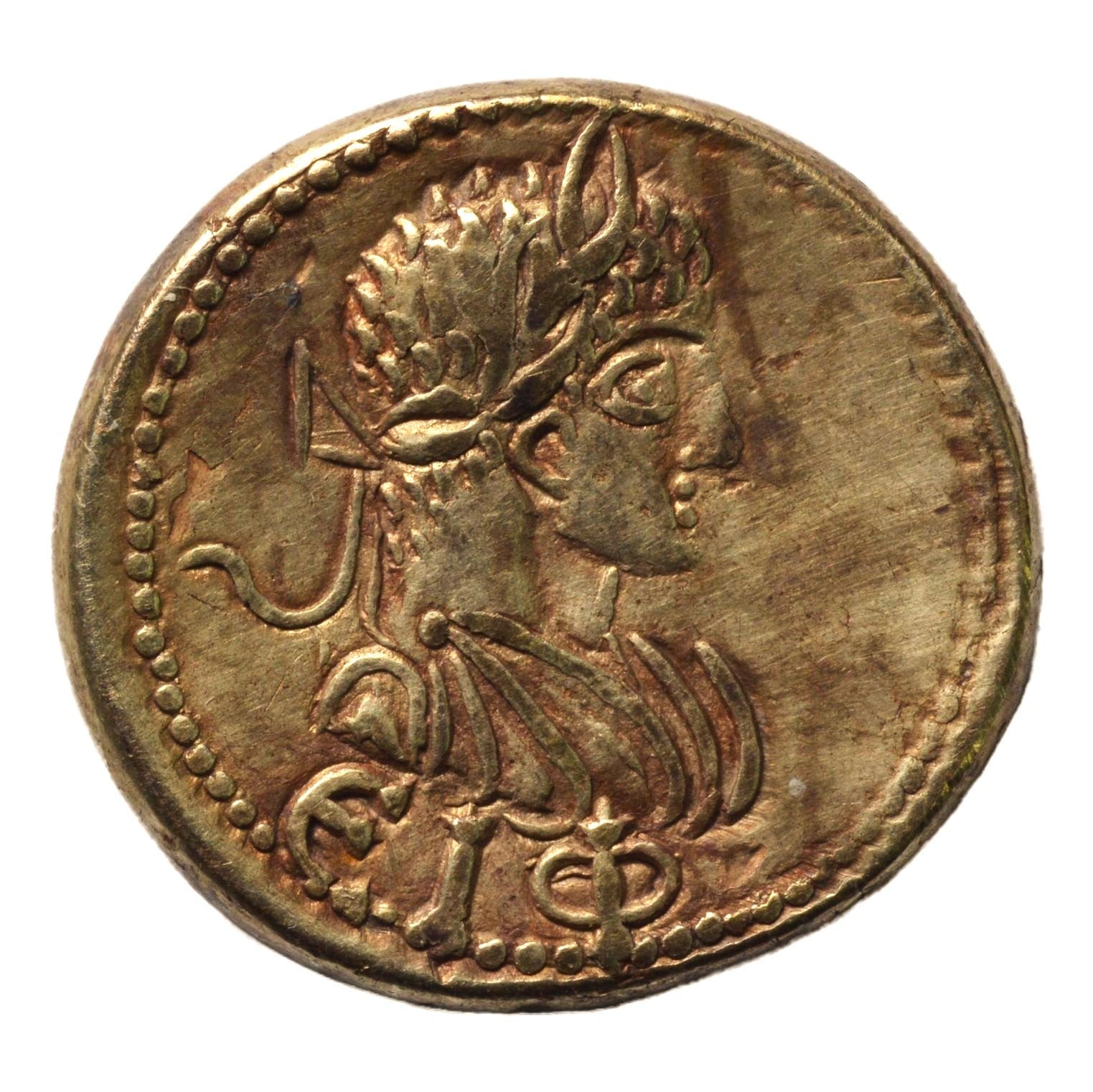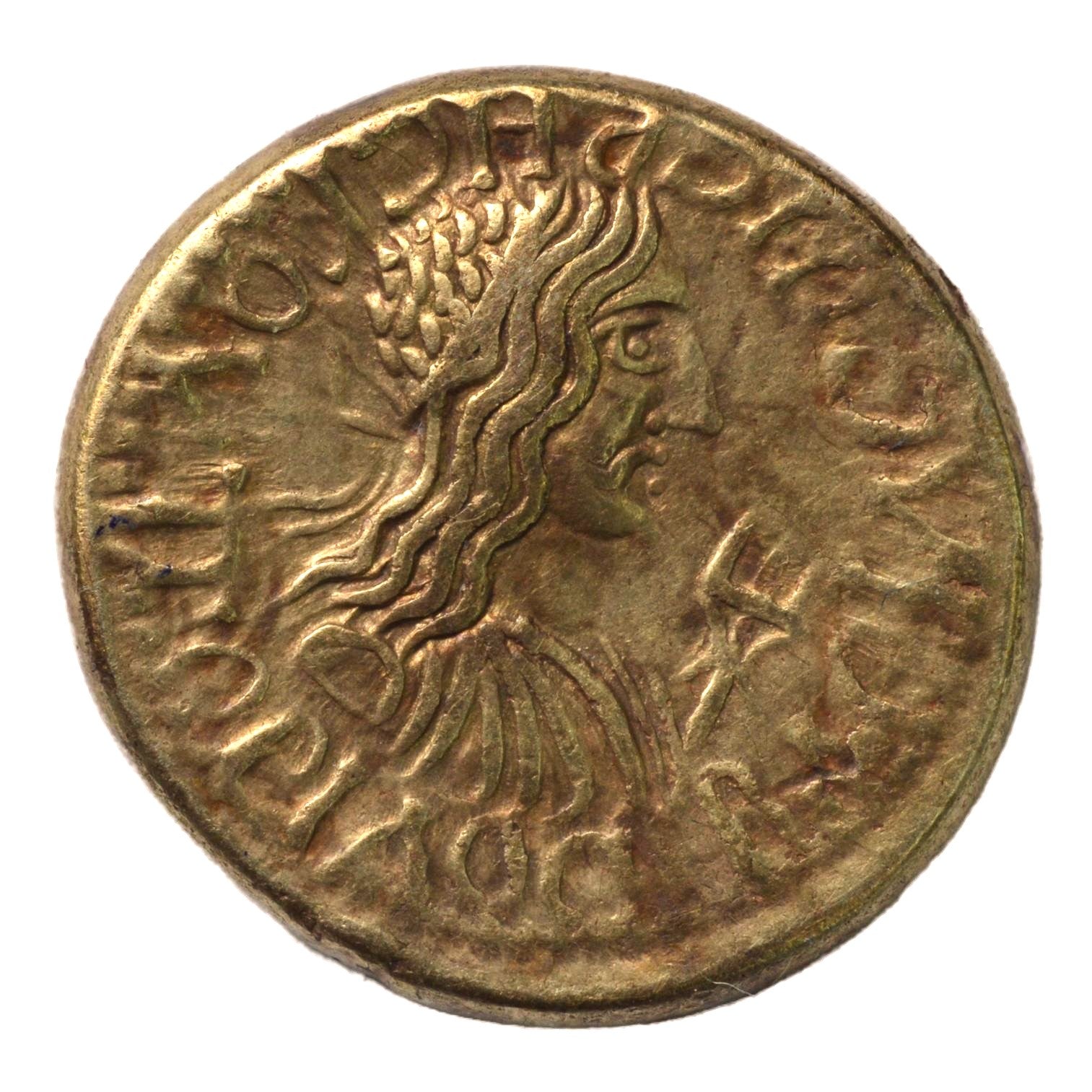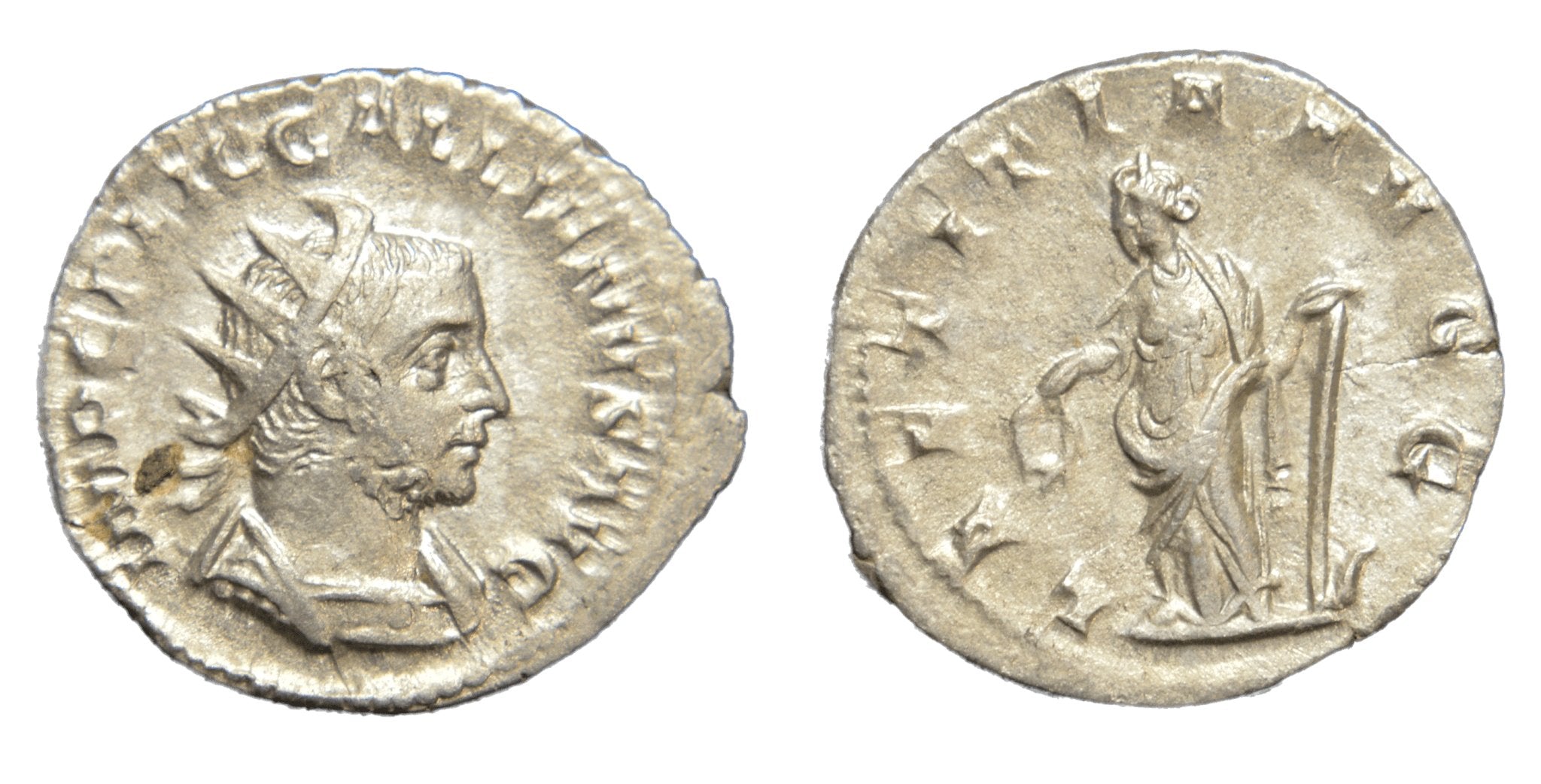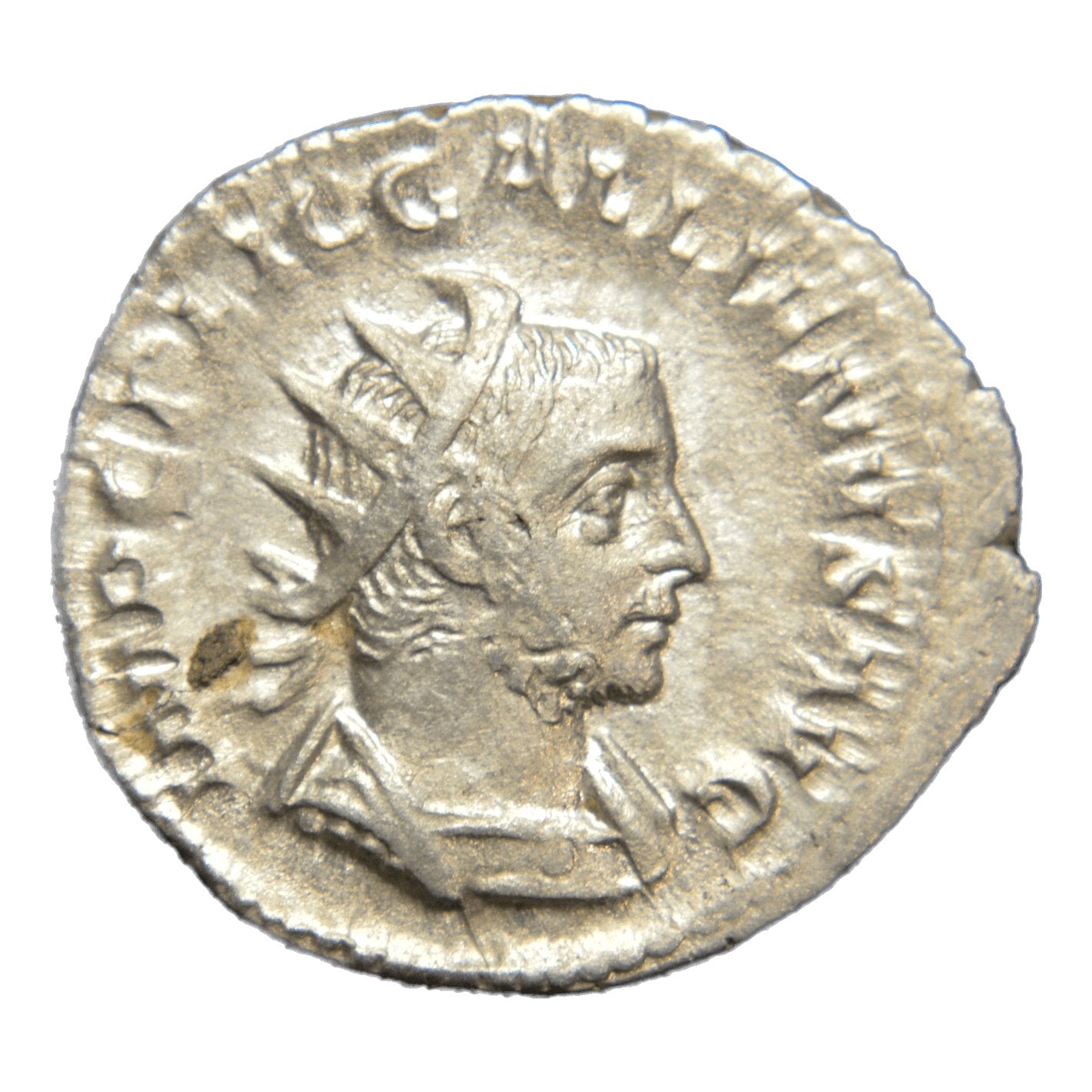In the aftermath of Caesar’s assassination, Rome witnessed a decade-long power struggle that was as dramatic as it was transformative. By the end of the War of Actium, Rome had done away with the Republican system, gone through a period of triumvirate rule, and become a fledgling Empire with Caesar Augustus (formerly known as Octavian) at the helm.
The transition that took Rome from Republic to Empire was a story of truly Shakespearean proportions – quite literally, considering the bard wrote not one, but two plays about it (Julius Caesar and Antony & Cleopatra).
This 14-year-long epic drama can be traced through the coins that were minted and left behind on the trail from triumvirate to Empire. One such coin tells a particularly important story: the legionary denarii utilized by Mark Antony in his treacherous attempts to take Rome back for himself. Economic history, overlooked though it may be, provides vital insights into the delicate relationships at play during the Roman Civil War.
As the saying goes: follow the money.
The Ides of March & The Plot for Revenge
On the 15th of March, 44 B.C., Julius Caesar was murdered by a group of conspirators that would later be known as the liberatores (the “liberators”).
This part we all know: he was stabbed 23 times at a Senate meeting, all of Rome mourned him, etc., etc. – then his great-nephew-turned-adopted-son, Octavian, became the first Emperor of Rome.

The Assassination of Caesar (1804) by Vincenzo Camuccini. Source: Wikimedia Commons.
But what exactly happened between these two events to turn Rome from a Republic ruled by a tyrant to an Empire ruled by his nephew?
Well, a lot happened. To be specific: 17 years, several wars, one triumvirate, and a whole lot of treachery.
Antony was first declared an enemy of the state when he attempted to take over Roman Gaul, which was being governed by one of the liberatores who had killed Caesar. Octavian took care of this issue, defeating Antony at the Battle of Mutina. In the aftermath of his success, Octavian returned to Rome and assumed control of the city (with the help of his 8 legions, many of whom were veterans from Caesar’s army).
At this point, in November of 43 B.C., Octavian joined forces with Mark Antony and Markus Aemilius Lepidus (Caesar’s former Master of Horse) to form the Second Triumvirate.
The Triumvirate established equal control over the Roman Republic: they would assume joint rule over Italy and divide the other provinces amongst themselves.
Together, the Triumvirate launched a war against Caesar’s murderers.
Mark Antony, Master of the East
After successfully avenging Caesar by defeating the leaders of the conspiracy (Brutus and Cassius) in the battles at Philippi, Mark Antony was given imperium over the East of the Roman Empire. And so, he headed eastward, first to Greece and then making his way across the lands of Rome (Phrygia, Cappadocia, Syria, Palestine, etc.).
This is where, as you might have guessed, he met Cleopatra – but not for the first time.
Cleopatra had been famously involved with Caesar in Rome, bearing him his son, Caesarion. This didn’t stop Antony from falling for her charms, just as his late friend did.

Cleopatra, Julius Caesar (left) and Mark Antony (right) as depicted in the 1963 film Cleopatra starring Elizabeth Taylor. Source: SNL.
Mark Antony and Cleopatra’s love story complicated things, to say the least. Living together in Alexandria, the pair had twins together before Antony returned to Rome where he – wait for it – married Octavian’s sister, Octavia.
Not a great start to a marriage, if you ask me.
And history would seem to agree. Antony’s ongoing romance with Cleopatra despite his marriage put a serious strain on his relationship with Octavian.
To make matters worse, Antony returned to the East, resumed shacking up with Cleopatra, gave her control over the lands of Southern Syria, and produced another child with her.
Soon enough, Antony and Octavia’s marriage was all but ended and Octavian’s resentment for him had grown very strong.
Before long, Rome would break into all-out civil war.
Actium: The Republic’s Last Civil War
In 32 B.C., with the support of the Roman Senate, Octavian finally declared war on Cleopatra – and by extension, on Mark Antony.
At this point, Octavian had become the sole ruler of Rome due to Lepidus’s (forced) resignation.
Meanwhile, in Alexandria, Antony publicly declared his alliance with Octavian over. Even more outrageous were Antony’s so-called Donations of Alexandria, an act in which he divided the territories of Eastern Rome amongst his children and Cleopatra (something which he had no authority to do, as far as Rome was concerned). To add insult to injury, he also divorced Octavian’s sister and officially married Cleopatra, meaning their children were now considered legitimate.
The actions taken in both Rome and Alexandria signaled that the hostility between Octavian and Antony had escalated to the point of war.
Both sides began to gear up for battle. For Antony, this meant he needed money fast, and a lot of it.
And so the military mints of Mark Antony were born.
After months of preparation, the two armies finally met on September 2nd, 31 B.C. at the Battle of Actium. Mark Antony’s troops suffered a crushing defeat at the hands of Octavian’s navy, led by Marcus Agrippa.
Mark Antony and Cleopatra retreated back to Alexandria, where they were outmatched again a year later.
When defeat seemed certain, Cleopatra fled the battle, followed closely behind by Mark Antony himself. In an unsurprisingly dramatic end, Antony committed suicide by falling on his sword. About a week later, Cleopatra followed suit – allowing a venomous snake to bite her, if the legend is to be believed.

The Death of Mark Antony with Cleopatra at Left (1778) by Johann Goerge Wille. Source: Metropolitan Museum of Art.
His greatest enemy vanquished, Octavian finally assumed full control of Rome. In 27 B.C., he was declared Augustus Caesar, first Emperor of the new Roman Empire.
Mark’s Mobile Military Mints
The army that Mark Antony amassed for his showdown with Octavian would total 70,000 in the infantry alone, plus 500 ships for the naval portion of the battle.
To fund this and pay his soldiers, Antony began minting what became known as the “legionary denarii” of Mark Antony. These were similar to the silver denarius of Rome – which was the most common coin in use at the time – with slightly decreased silver content of about 92.2%, as compared with the 96.84% of the Roman denarii.
It is believed that some of these coins were struck at Mark Antony’s base in Patrae, Greece, while others were minted on the move. Mobile workshops traveling around with Mark Antony’s army may have been responsible for the creation of these now-iconic legionary denarii.
These coins are characteristically large and feature legionary imagery where a ruler’s likeness would normally be. The inclusion of symbols referencing specific legions communicates the admiration and respect Mark Antony had for his own soldiers – and was a rather clever tactic of propaganda, I might add.
For example, the coin pictured below (which you can buy here) features two very recognizable military icons.
On the left is the aquila (eagle), a symbol representing the Roman legions. The eagle flies between two legionary signa(standards). It is inscribed with the letters LEG (legionis or “of the legions”) and a number indicating a specific legion – in this case, X (10).
Depicted on the opposite side is a decorated galley with its oars being rowed. (On this specific coin can also be seen a unique marking of graffito.)
Above the galley are printed the letters:
ANT AVG
(Antonii auguris)
Below the galley, it reads:
III VIR · R · P · C(tresviri rei publicae constituendae)
All together, this means:
“of Antony, the augur and one of the triumvirs for organizing the Republic.”

Legionary denarius of Mark Antony, from his moving military mints (32 – 31 B.C.) Available here.
Mark Antony’s Legionary Legacy
Mark Antony’s legionary denarii were not typically hoarded due to their relatively low silver content (although, it should be noted, silver debasement was about to get a lot worse in Rome). Instead, they were often kept in circulation – and remained circulating for hundreds of years after Mark Antony’s death!
The legionary denarii of Mark Antony are iconic for several reasons:
- They featured images paying homage to the legions, rather than to leaders or gods.
- They were minted in rebellion, outside of Rome, and likely by mobile workshops traveling with Antony as he geared up for battle.
- They provide a rare glimpse into how Mark Antony was representing himself in his attempts to rise to power – while most of the historical sources after his defeat reflect Octavian’s narrative of Antony.
For all these reasons and more, Mark Antony’s military coins have become particularly popular among collectors and history buffs alike. They tell a story unlike any other – one of betrayal, unbridled ambition, and even love. The legionary denarii represent a vital period of transition from Republic to Empire, with Mark Antony’s death marking the close of a tumultuous chapter in Roman history.
On his path from triumvir to enemy of Rome, these legionary denarii were all he left behind.
Sources & Further Reading
“Between Greece and Rome: Coinage in the Imperium of Mark Antony” by Andrew Meadows, University of Oxford (June 29, 2020).
“The Battle of Actium: A Reconsideration” by Carsten Hjort Lange in The Classical Quarterly (December 2011).
“The Legionary Denarius of Mark Antony” by James Grout, University of Chicago.
“Antony’s Legionary Denarii” by Campbell Orchard, University of Warwick (March 24, 2022).
“CoinWeek Ancient Coins – The Legionary Denarii of Mark Antony” by Michael Shutterly, on CoinWeek (July 12, 2022).

